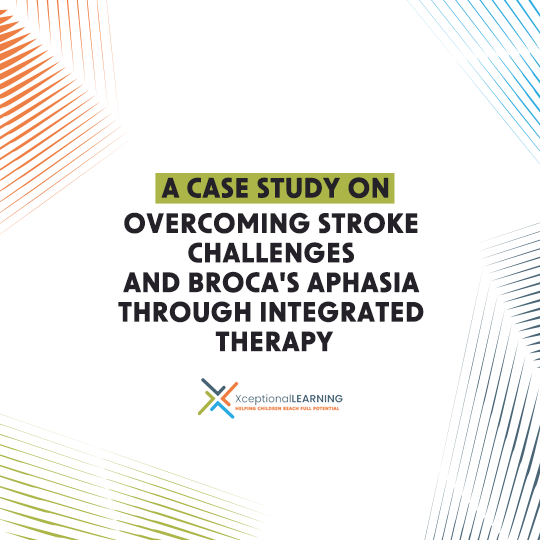A Case Study on Overcoming Stroke Challenges and Broca’s Aphasia Through Integrated Therapy
admin September 4th, 2024
Consultant Speech Swallow pathologist, Digital practitioner -SLP
At 45, Ravi’s life took an unexpected turn when a stroke left him with Broca’s aphasia, a condition that impaired his ability to speak while largely preserving his understanding. Struggling to express himself verbally, Ravi embarked on a journey of recovery supported by innovative, technology-enhanced therapy sessions. These digital sessions, tailored to his specific needs, incorporate interactive exercises and multimedia tools to make the process engaging and effective. Through consistent practice and a targeted approach, Ravi is gradually regaining his communication skills, along with newfound confidence and independence.
Enhancing Therapy with Technology: Ravi’s Personalized Approach
Ravi’s therapy program is a shining example of how technology can elevate therapeutic practices. By integrating digital tools and platforms, his therapy sessions are engaging and effective. Here are some key activities that have been instrumental in his progress:
1.Speech Sound Production Practice:
Digital tools allow him to practice speech sounds with real-time feedback, helping him improve articulation and speech clarity.
2. Interactive Vocabulary Building:
Using interactive apps, he engages in exercises to expand his vocabulary, enhancing his ability to find and use the right words in conversation.
3. Sentence Construction Exercises:
These activities focus on helping him construct sentences, gradually increasing in complexity to improve his grammatical skills.
4. Picture Naming Tasks:
Ravi practices naming pictures displayed on the screen, which aids in word retrieval and enhances his expressive language skills.
5. Functional Communication Scenarios:
Digital simulations of real-life scenarios provide him with opportunities to practice functional communication, improving his confidence and ability to interact in daily situations.
6. Reading and Comprehension Activities:
Ravi engages in reading exercises that match his comprehension level, helping him improve his reading skills and understand written language better.
7. Voice Recording and Playback:
Recording his voice during practice allows him to hear his progress, identify areas for improvement, and gain confidence in his speech abilities.
Progress Through Consistent Digital Therapy
Ravi’s consistent engagement in digital therapy activities has led to remarkable progress across several areas. His articulation has improved, resulting in clearer speech production. He has expanded his vocabulary, enhancing his ability to select and use words effectively. Ravi’s sentence construction skills have also seen significant improvement, enabling him to form grammatically correct sentences more easily. His word retrieval has become more accurate and swifter, aiding in naming objects with greater efficiency. Additionally, Ravi demonstrates increased confidence in using language during daily interactions, thanks to functional communication practice. His reading skills have improved, leading to better comprehension and understanding of text. Finally, increased self-awareness has been achieved through voice recordings, allowing him to recognize and celebrate his progress. These advancements highlight the effectiveness of a consistent digital therapy approach in driving Ravi’s development.
Recommendations for Future Therapy Plans
As Ravi continues to progress, here are some recommendations for future therapy plans to further support his development:
- Advanced Speech Sound Practice: Introduce more complex speech sounds and combinations to refine articulation further.
- Storytelling and Narrative Skills: Engage in storytelling activities to enhance his ability to organize and express his thoughts coherently.
- Thematic Vocabulary Expansion: Teach new vocabulary in thematic units such as professions, hobbies, and emotions to broaden his language base.
- Complex Communication Scenarios: Gradually introduce more complex communication scenarios to improve his ability to handle nuanced conversations.
- Group Therapy Sessions: Incorporate group therapy sessions to promote social interaction and practice conversational skills with peers.
- Integration of Multi-modal Communication: Encourage the use of gestures, writing, and drawing alongside speech to facilitate communication.
- Family Involvement: Involve Ravi’s family in therapy sessions to reinforce learning and provide a supportive communication environment at home.
Ravi’s journey exemplifies how personalized digital therapy, coupled with determination, can lead to significant improvements for individuals facing similar challenges. Despite the difficulties posed by conditions like Broca’s aphasia following a stroke, patients can achieve remarkable progress in their communication abilities. This case highlights the importance of engaging, interactive, and consistent therapy activities in fostering growth and development. By embracing a tailored approach to therapy, individuals can experience transformative outcomes and enhanced quality of life. At XceptionalLEARNING Platform, we provide personalized therapy plans tailored to individual needs. Our services include access to certified therapists, convenient online sessions, and continuous progress tracking, all aimed at supporting individuals in achieving clear and confident communication. If you or a loved one are navigating similar challenges, contact our team today to schedule a demo and experience how tailored digital therapy can make a difference in your journey.

